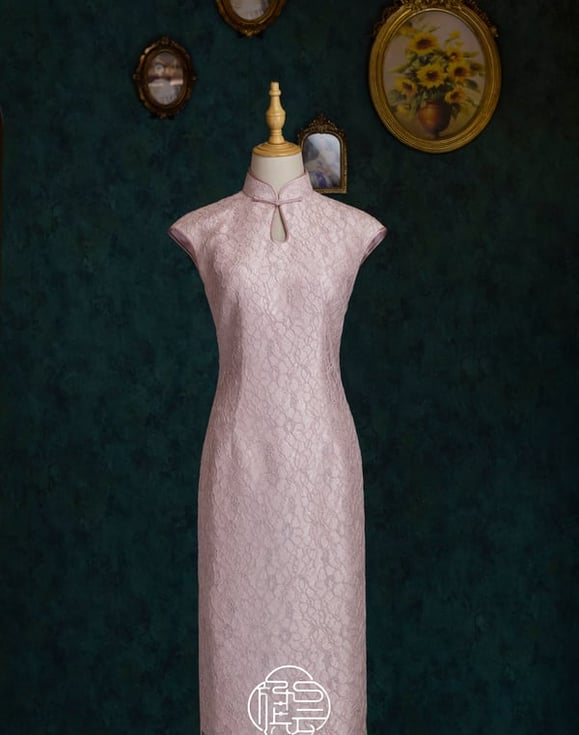What Does Qipao Mean
The qipao (or cheongsam), a traditional Chinese garment, symbolizes grace, cultural continuity, and historical evolution. Originating from the Manchu "banner people" (旗人) attire of the Qing Dynasty (1644–1912), its name reflects its roots: "旗" (banner) + "袍" (robe).
QIPAO KNOWLEDGE
5/29/20253 min read


Historical Origins and Evolution
The qipao traces its roots to the clothing of the Manchu people in the Qing Dynasty (1644–1912). During this period, the Manchu ruling class established the "banner system," a social and military organization, and their traditional robes—loose-fitting, long, and practical for horseback riding—became synonymous with their identity. These early robes featured a straight cut, a high collar, and symmetric front buttons, emphasizing modesty and functionality.
In the early 20th century, as China underwent social and political changes (such as the Xinhai Revolution in 1911), the qipao began to evolve. Influenced by Western fashion and the feminist movement, urban women in Shanghai and other cosmopolitan cities adapted the garment. The loose silhouette was tailored to be more form-fitting, showcasing the wearer’s figure while retaining traditional elements like the mandarin collar and frog-button closures. This modernized qipao became a symbol of women’s emancipation and cultural fusion, blending Eastern and Western aesthetics.
Cultural Symbolism
Gender and Femininity:
The qipao’s transformation in the 民国 (Republican era) marked a shift in how Chinese women expressed themselves. The form-fitting design challenged traditional modesty norms, allowing women to embrace their femininity confidently. It became a staple in urban high society, worn by celebrities, socialites, and even political figures, symbolizing modernity and sophistication.
National Identity:
After the founding of the People’s Republic of China in 1949, the qipao fell out of favor during the socialist era, seen as a relic of the past. However, it experienced a revival in the late 20th century, particularly in Hong Kong, Taiwan, and overseas Chinese communities. Today, it is recognized as a quintessential Chinese cultural icon, often worn during festivals, weddings, and international events (e.g., the 2001 APEC summit, where leaders wore modernized qipao-inspired jackets).
Art and Fashion:
The qipao’s elegance has inspired artists, filmmakers, and designers worldwide. In literature and film (e.g., Zhang Yimou’s Shanghai Triad or 王家卫’s In the Mood for Love), the qipao symbolizes mystery, nostalgia, and cultural depth. Fashion designers like Guo Pei and Vivienne Tam have reimagined it with contemporary fabrics and cuts, blending tradition with avant-garde styles.
Design Elements and Craftsmanship
A classic qipao features:
Mandarin Collar: A high, upright collar symbolizing dignity.
Frog Buttons: Decorative knot buttons, often in intricate patterns, running diagonally from the collar to the side.
Side Slits: Traditional or modern qipao may have slits on the sides, adding mobility and a touch of allure.
Silhouette: Historically loose, later tailored to emphasize the waist and hips, with lengths varying from ankle-length to knee-length.
Fabrics and Embellishments: Silk, brocade, or cotton are common, often adorned with embroidery, beadwork, or symbolic motifs (e.g., dragons, phoenixes, flowers).
Crafting a qipao requires meticulous tailoring, as the fit must balance tradition with the wearer’s body shape. Each stitch and pattern carries cultural meaning, making it both a garment and a piece of art.
Qipao in the Modern World
Today, the qipao transcends cultural boundaries. It is worn globally as a symbol of Chinese fashion, appearing in international runways, weddings, and cultural celebrations. In China, it remains a popular choice for special occasions, such as the Lunar New Year or graduation ceremonies, connecting younger generations to their heritage.
Moreover, the qipao’s meaning extends beyond clothing. It represents the resilience of Chinese culture—adaptable yet rooted in history, elegant yet modern. As a bridge between past and present, it continues to captivate the world, inviting appreciation for the beauty of tradition in a contemporary context.
In essence, the qipao is more than a robe; it is a narrative of China’s evolving identity, a celebration of femininity, and a timeless symbol of grace.
The qipao, also known as the cheongsam, is a traditional Chinese garment that embodies elegance, cultural heritage, and historical evolution. Its name combines two Chinese characters: "qi" (旗), meaning "banner" or "standard," historically referring to the Manchu ethnic group (the "Banner People" during the Qing Dynasty), and "pao" (袍), meaning "robe." Together, "qipao" literally translates to "Banner robe," reflecting its origins and cultural significance.


